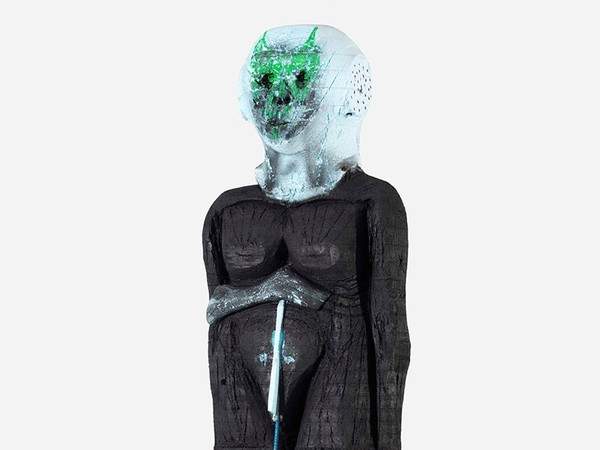Rome: Huma Bhabha at the Gagosian Gallery with the exhibition The Company
Gagosian Gallery, in its Rome location, presents The Company, an exhibition of new sculptures and drawings by Huma Bhabha (Karachi, 1962), from Sept. 19 to Dec. 14, 2019. This is the first time the Pakistani artist is exhibiting in Rome. Through expressive drawings on photography and figurative sculptures carved in cork and Styrofoam, made from discarded materials and clay, or cast in bronze, Bhabha explores the tensions between time, memory, and uprooting. Between science fiction, archaeological remains, Roman ruins, and postwar utopia, the artist transforms the human figure into sneering totems, at once disturbing and sinisterly funny figures.
The Company is partly inspired by The Lottery in Babylon (1941), a short story by Jorge Luis Borges in which an imaginary society is overwhelmed by the system of a looming lottery that dispenses rewards and punishments. The lottery is supposedly directed by the Company, a secret, perhaps nonexistent body that decides people’s fates. Bhabha’s procession of sculptures reveals the power of this mysterious Company. This includes a pair of large hands disjointed from the body that seem to float on transparent pedestals; a seated figure; and numerous standing figures of different sizes. Drawings on photography recall these figures, which could be from a distant futuristic realm as well as from a lost civilization. The standing figures are carved from stacks of dark cork, emanating an acrid earthy smell, and its technical opposite, Styrofoam. These materials, looking hard and compact, like eroded stones and freshly quarried marble, are actually light and soft and allow Bhabha to sculpt quickly and spontaneously without finishing. The sculptural process thus becomes a kind of stream of consciousness from which alien monsters, fertility gods and Greek kouroi emerge.
The faces of Bhabha’s mask-like sculptures are at once majestic and disturbing. Painted in striking pastel tones (light blue, mauve, pink and green) they recall graffiti, in which urban dirt is mixed with brightly colored pictorial interventions. With their crazy cartoonish features reinforced by prophetic bipedalism, Bhabha’s sculptures seem both to mock and to warn, as reflections on and witnesses to human pride and power, veneration and iconoclasm.
Juxtaposing scars of war, colonialism, and trauma with allusions to current events and mass media, Bhabha has long argued that the world is an apocalypse, created by both man and nature: his looted sculptures seem to witness a certain catastrophe that they have managed to survive to tell its story. Like a pharaoh on a throne or a cyborg hit by a shower of shrapnel, a seated figure is made of yellowish clay compressed into wire mesh, stained Styrofoam fragments, dog toy bones and rusted chairs from Karachi, Bhabha’s hometown, trapped in a crossfire of internecine and international conflicts.
In Bhabha’s large-scale drawings, human and nonhuman figures inhabit the space shared by photography, collage and painterly gestures: their disparate faces and indistinct shapes seem to haunt landscapes, city streets and architectural sites. In one of these, a blue and beige arch interferes with a photograph Bhabha took in Rome’s Capitoline Museums of an ancient statue of a dog, with two white kouroi looming in the background.
Huma Bhabha was born in 1962 in Karachi, Pakistan, and lives and works in Poughkeepsie, New York. Her work is included in the collections of the Museum of Modern Art, New York; Metropolitan Museum of Art, New York; Whitney Museum of American Art, New York; Bronx Museum of Art, New York; Hammer Museum, Los Angeles; Museum of Fine Arts, Houston; Centre Pompidou, Paris; Collezione Maramotti, Reggio Emilia, Italy; and the Art Gallery of New South Wales, Sydney. Recent institutional exhibitions include Huma Bhabha, Aspen Art Museum, CO (2011-12); Players, Collezione Maramotti, Reggio Emilia, Italy (2012); Unnatural Histories, MoMA PS1, New York (2012-12); We Come in Peace, Roof Garden Commission, Metropolitan Museum of Art, New York (2018); Other Forms of Life, Contemporary Austin, TX (2018 -19); and They Live, Institute of Contemporary Art, Boston (2019). Bhabha has participated in the exhibitions Intense Proximity, La Triennale, Paris (2012); All the World’s Futures, 56th Venice Biennale (2015); and 57th Carnegie International, Carnegie Museum of Art, Pittsburgh, PA (2018).
Pictured: Huma Bhabha, Beyond the River (2019), cork, Styrofoam, iron rod, wood, acrylic, and oil stick, 76.2×94×261.6 cm.
Source: release
 |
| Rome: Huma Bhabha at the Gagosian Gallery with the exhibition The Company |
Warning: the translation into English of the original Italian article was created using automatic tools. We undertake to review all articles, but we do not guarantee the total absence of inaccuracies in the translation due to the program. You can find the original by clicking on the ITA button. If you find any mistake,please contact us.



























